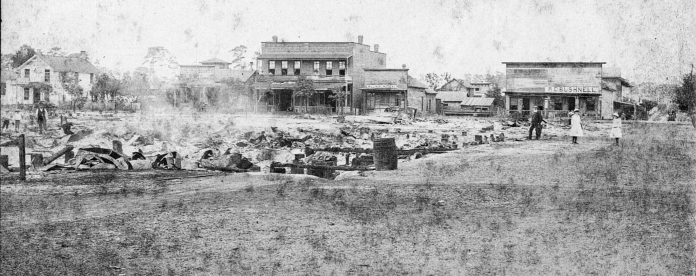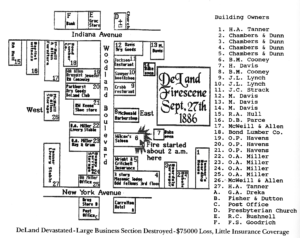
A story of destruction, but of valor, too
In the early-morning hours of Sept. 27, 1886, the new moon’s utter darkness had engulfed the streets of Downtown DeLand.
The string of businesses that lined those streets — DeLand’s esteemed “crown jewels” — stood silent; they had been shuttered for the night.

The Beacon is indebted to Donna Jean Flood, a DeLand financial adviser
with Edward Jones, for the idea for this series, part of our ongoing West Volusia Memories series by community writers.
Suddenly, a cry of alarm sounded, striking shock and dread in all who heard. It took a little time for the growing shouts of “Fire!” to penetrate the awareness of the sleeping residents, but, then, in a rush of action, they rallied.
People beat on pots and pans and fired guns to spread the alarm, but the blaze already had a critical head start.
The first flames had been discovered in the rear of the Wilcox Saloon. To more easily maintain his “neat” establishment, Wilcox had covered his barroom floor with sawdust.
The combination of sawdust with the heavy smoking that went on in the saloon always posed a grave threat. It’s not surprising that, despite Wilcox’s fervently expressed opinion to the contrary, most people came to believe that the origin of the potentially deadly Downtown fire was an incompletely extinguished cigar that had lain smoldering on the saloon floor and eventually ignited the super-combustible sawdust.
The flames, flowing like a river of fire over the crisp, dry wood shavings, would have taken only moments to spread up the walls and engulf the entire building.
Because all the Downtown structures were built with lumber from the surrounding resinous longleaf pine forests of the Orange Ridge, the adjacent buildings quickly were blanketed in flames and fell like dominoes in the blazing inferno.
Bucket brigade to the rescue

FIRE BRIGADE — A very early version of the DeLand Fire Department rushes down Woodland Boulevard. The
photograph is labeled “Fire of 1886.”
The Volunteer Fire Department that had been organized just one year earlier responded as quickly as it possibly could. Their equipment was kept in the covered skating rink on New York Avenue, so in the time it took for the crew and equipment to assemble and race to the scene, the fire was already out of control.
Intense, heat-created winds carried the blaze to businesses on either side of the saloon. Firebrands (pieces of burning wood) rained from the sky, sparking blazes at each place they touched down. Structures burned with such fury that the heat radiated for great distances.
Virtually every able-bodied person, black and white, was put to work.
A veil of crimson now covered the block and pushed relentlessly southward. The citizenry’s biggest concern was that the fire would threaten Dreka’s Department Store — which was topped by the Carrollton Hotel at the southeast corner of Woodland Boulevard and New York Avenue — and from there would go on to destroy the south end of town.
The firefighters skipped over buildings they had little hope of saving, and concentrated all their efforts on saving Dreka’s building.
As firebrands fell all around them, people hung blankets from the railings of the hotel’s verandas, and then ran up and down from the rooftop water tank, dashing buckets of water on the blankets to keep them soaked.
It appeared at first that these bucket brigades had failed, when the front of the building started to scorch and one of the desperate crew was overheard crying out “My God, must it burn?”
Nevertheless, the people fought on. They were finally able to subdue the fire at the Dreka site.

Remarkable saves
There were a few other businesses that, like Dreka’s establishment, defied the odds and were rescued by the citizens’ incredible persistence and valiant effort.
To prevent Fisher’s drugstore at the southwest corner of Woodland Boulevard and West New York Avenue from catching fire from the burning livery across the way, the building was wet down with water from a backyard tank.
Just when the fire at the livery reached its peak, the tank ran out of water and the drugstore shingles began to smoke.
A man identified by Helen DeLand as “Mr. Spaulding” discovered tanks of carbonated water under the drugstore soda fountain, which provided the firefighters with “a chemical fire extinguisher right at hand.”
The tank was taken outside to New York Avenue, and Mr. Spaulding, his head and back wrapped in a wet carpet, sprayed the building, saving it.
Other individuals took noteworthy actions. Mayor Fred Goodrich moved up and down the streets urging the firefighters to keep going.
Employing a large mule whip, Goodrich drove any potential slackers back into the midst of the flames to do their share in the fight. When potential looters approached, Goodrich dealt with them by use of “strong language and forceful tactics.”
Though it must have seemed to the firefighters as if many hours had passed, Helen DeLand was later told that it took only two hours from the time the first call was received until all the flames were finally extinguished.
The coming of daylight revealed the breadth of the devastation. Although their hard work and dedication had prevented a total loss of all the Downtown buildings, the sight of so many ruined structures was still staggering to behold.
Between New York and Rich avenues, two full blocks of the Woodland Boulevard business district lay in ash and rubble. The feeling of devastation was tempered, however, by the amazing news that no lives had been lost.
— Contact the West Volusia Historical Society at 386-740-6813, or email delandhouse@msn.com to order a copy of Ryder’s book Better Country Beyond. Proceeds from the sale benefit the Historical Society.
Thank you for sharing this story. I bought a dress at Betty Drekas with my mom in 1984 and it is a nice memory. I had no idea Drekas was such a historical place. How interesting!
I love this local history! Keep up the awesome work. I work with Dan Friend and Deland with Deland historic trust and live on the east side at the History house in Holly Hill. Never enough local history we need to keep spreading and preserving our passion for the stuff!